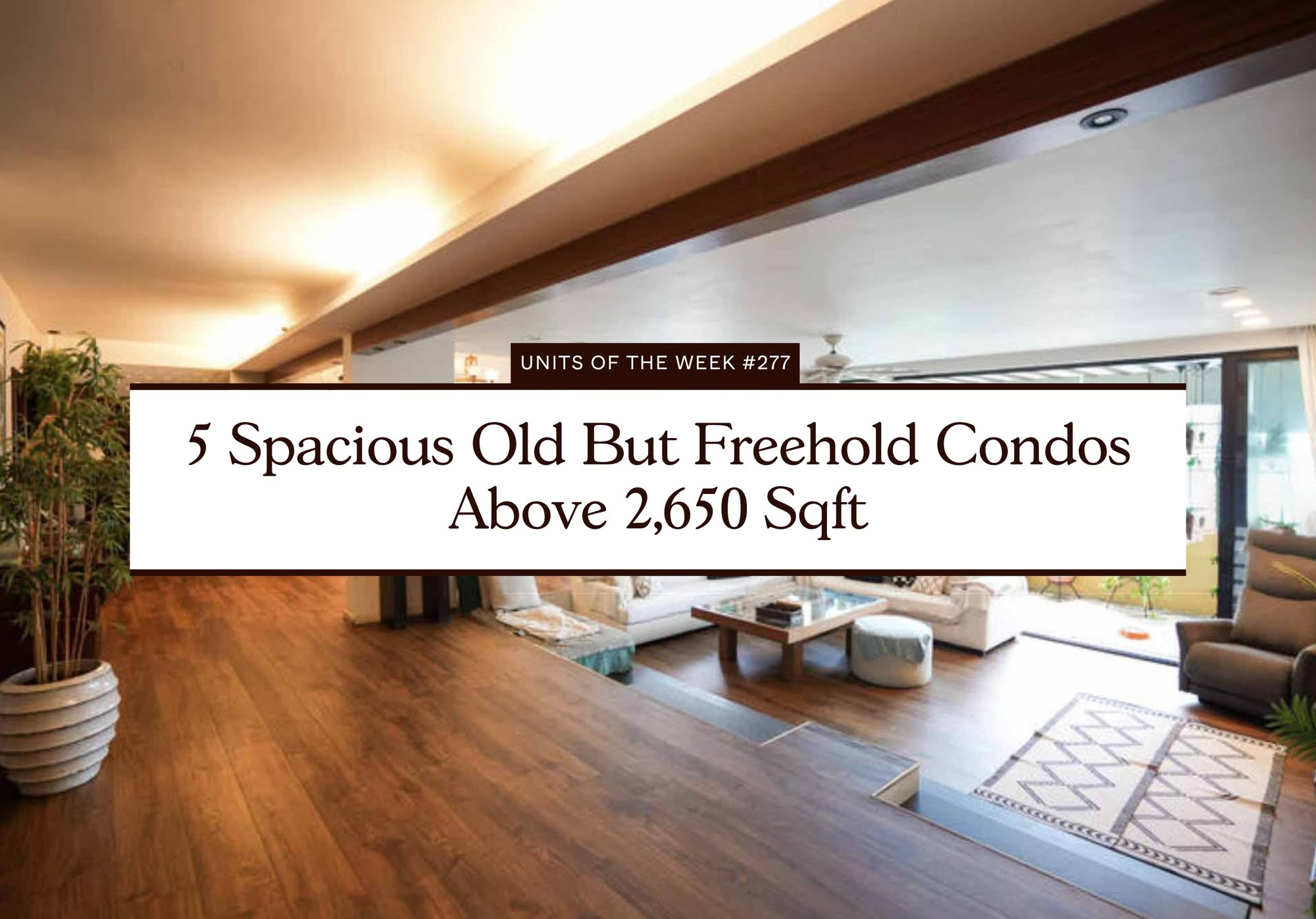9 Must-Know Tips To Design A Pet-Friendly Home In Singapore

Get The Property Insights Serious Buyers Read First: Join 50,000+ readers who rely on our weekly breakdowns of Singapore’s property market.
A seasoned content strategist with over 17 years in the real estate and financial journalism sectors, Ryan has built a reputation for transforming complex industry jargon into accessible knowledge. With a track record of writing and editing for leading financial platforms and publications, Ryan's expertise has been recognised across various media outlets. His role as a former content editor for 99.co and a co-host for CNA 938's Open House programme underscores his commitment to providing valuable insights into the property market.
As of 2022, Singapore’s total fertility rate was at a historic low of 1.05 average live births for each woman in her reproductive years. We’re a rapidly ageing population, and empty-nesters (married couples whose children have left) face two choices: empty and dull households, or ones with other different lives to take care of.
Accordingly, more Singaporeans are taking on pets – and the status of pets in our households is quickly rising (DINKWADs anyone?). Perhaps in place of grandchildren, fur babies have started to place themselves on the family throne.
In light of this, it’s time to look at how our interiors can better cater to pets:
A quick note for tenants
Besides finding a landlord who allows pets, we strongly suggest you opt for unfurnished or semi-furnished units. This will save you the hassle of damaged inventory and lost safety deposits later. Besides this, you’ll want control over the furnishings, so you can get what’s appropriate for your pet(s).
1. Additional barriers for ground floor units

In contrary to popular opinion, depending on your pet, it sometimes may be better not to get a ground floor condo unit. That’s because, on the ground floor, pets dashing out the front door might make it straight into the outdoor areas and eventually onto the road (unless your condo has an enclosed lobby.)
This sort of thing is less probable on a higher floor, as most pets haven’t figured out how lift buttons work; and fire escape stairs are usually behind closed doors.
That said, if you are on the ground floor, do consider additional barriers to stop your pet from dashing out. Some pet owners use low safety gates – of the same sort used for toddlers – to keep pets out of the living room and away from the main door. We’ve also seen added low fencing around patio areas, if your condo unit has these.
This may not work for every pet, as some are big and agile enough to bypass the barriers; but it will at least stop a puppy, kitten, etc. from making it out the front door.
2. Pick the right flooring materials for your pet
Unless it’s a fish or bird, you may be better off with non-wood flooring. Many forms of wood can be permanently stained if your pet defecates on it; and if it happens when you’re out, it may have been seeping into the wood for several hours. This is especially a concern for new pets, which haven’t yet been toilet trained.
That aside, some pets also have claws. While you may not see the effects at first, three or four years of scrabbling claws will eventually leave scratch marks on the wood; and simply re-varnishing everything may not be sufficient to fix it.
A final consideration here is fleas. If you use parquet flooring, there are sometimes gaps between the wooden slats; and this may explain why your pet’s flea problem never seems to fully go away.
Harder materials, like marble, can also be stained by faeces or urine; and scratch marks can also show up over time. Some contractors and pet owners have told us porcelain or terracotta tiles hold up the best, but consult with your designer on the specifics. Do note that very smooth tiles are uncomfortable for pets, and they will lose traction if they run or jump; that makes it more likely for them to slide and slam into something.
If you don’t mind simple laminates, these really are the best option for pets.
3. You can customise storage spaces to include pet spaces

This helps to maximise your square footage too, as your pet doesn’t have to take up a space in the middle of a living room, or get underfoot in the kitchen. Most pets also like the sense of security that comes from a fully sheltered space.
For multi-storey landed properties, staircases are usually quite wide. Your Interior Designer might have a way to use the room under the stairs as a pet corner, or a place to store the various pet items (leashes, food bowls, shampoos, etc.)
There is also a use for low bay windows, as an area for a pet bed (finally, a use for a feature that’s often a waste of space). But this varies based on the pet in question – if it’s too high up, beware of injuries if your pet tries to jump down.
For retirees, or young couples without children (and who don’t intend to have any), you might consider giving up some larger storage spaces for pets. Wardrobes, for instance, are more easily reconfigured as they’re rather spacious.
4. Create higher storage spaces for plants
Unless you want to come home and find your plants ripped up and scattered over the floor (along with the soil), it’s best to keep it out of reach of pets. This is especially a worry around upper-floor balcony areas, where pets may knock potted plants off the edge. Police reports do happen because of this.
You might want wall-mounted or suspended platforms for plants; or just place them in a room that pets can’t access without your supervision.
Because Singapore’s tropical climate is a bug haven, do also keep in mind that plants attract other creepy-crawlies. This is especially the case for ground floor units, or landed homes with yards. You may want to use gates or other obstacles to block off pets from these areas, lest they eat something poisonous.
5. Include a pet-washing station
It’s nice to see NParks is in on this already, but pet-washing stations can be installed in the home as well. As pets rise in prominence, it’s unsurprising we might customise our bathrooms for them.

It’s much more convenient to bathe your pets if you have these in your bathroom. Otherwise, you might need to have a bathtub or have an epic struggle in a standing shower. If you don’t want to fork out for a custom design, you can also use a range of ready-made pet-washing sinks. In these cases, you can just ensure there’s a nook in the kitchen or bathroom where it’s convenient to place this.
As an added bonus for older folks, this is much safer than trying to stand and bathe your pet.
6. Try to use smoother materials for fabrics
In general, cats are more likely to scratch and bite at materials with a lot of tactile sensation; that’s why scratching poles are deliberately rough. Open-weave fabrics, like corduroy or knits, tend to snag claws even if your cat doesn’t want to scratch it.
If you use smooth fabrics like velvet, you may find your cat is less interested in clawing it to pieces. However, this isn’t universal, as pets have different personalities and preferences. Also, velvet is not great with dogs that shed a lot, as all that fur tends to stick to it.
Leather and canvas are generally recommended for pets. Even though leather (real or fake) might show a few claw marks, it’s generally easier to clean off, be it urine or fur. Canvas is hard to claw apart, easy to clean, and doesn’t tend to hold smells; but thick canvas fabrics are usually used for outdoor furniture, so you may not always find it in an indoor sofa set.
7. Ventilation is vital when keeping pets
If you don’t want the smell of your pet to linger, it takes more than just grooming. Beware of older layouts with a lot of corridors and corners, with poor airflow – these are more likely to trap odours, so you may need to add air purifiers. Not the tiny ones on tables either, but the heavy-duty standing models for entire rooms.
Newer layouts, which tend to emphasise fewer partitions, open kitchens, dumbbell layouts, etc. are frankly better for pet owners. If the unit is angled to ensure airflow between the balcony to the service yard, odours are quicker to dissipate.
An added concern here is whether you want to have ceiling fans. We know some people find these hard to maintain – but if you open the windows and use fans, it circulates the smells away faster than if you just use an air-conditioner.
8. Consider the location of your power outlets, and likely extensions or cables
Ideally, you want these to be tucked away from pets. Wire concealers, PVC pipes, and other such protections are essential – but it’s best to ensure they’re not close to pet beds, or corners where your pets like to hang out. It may even be worth paying to move the power socket, rather than risk having your pet electrocuted.
(Or yourself electrocuted, if you grab at a wire that’s been chewed)
Most pet owners will make it a point to unplug everything and keep cables away, if they’re leaving the house for some time. This means a lot of ducking down and plugging / unplugging things, so make sure it’s not too inaccessible for you either.
9. Keep furnishings light and minimal, as cleaning will require more effort

This is a simple fact of owning pets: you’ll need to clean more thoroughly, whether it’s clearing out clumps of fur, digging out ropes, balls, and other toys from sofas, or finding hidden treasure (i.e., treats that get hidden in creative places).
If you opt for a design theme with a lot of heavy and hard-to-move furniture, we hope you have a domestic helper, or very co-operative children with the chores. It’s best to stick with more minimalist designs, and more streamlined furnishings that can be moved out of the way.
There’s also a safety element: densely packed rooms with lots of furniture mean a lot of sharp corners to run into. There’s also the risk of knocking over mirrors or display cases, and showering the floor with glass.
It’s generally best to steer clear of Victorian/French Cottage/Art Deco-type themes, where a pet is involved.
For more help in getting your home interior right, you can also reach out to us on Stacked, and we’ll find you the appropriate experts. Also, follow us for insights on new and resale projects alike. If you’d like to get in touch for a more in-depth consultation, you can do so here.
Ryan J
A seasoned content strategist with over 17 years in the real estate and financial journalism sectors, Ryan has built a reputation for transforming complex industry jargon into accessible knowledge. With a track record of writing and editing for leading financial platforms and publications, Ryan's expertise has been recognised across various media outlets. His role as a former content editor for 99.co and a co-host for CNA 938's Open House programme underscores his commitment to providing valuable insights into the property market.Read next from Property Advice

Property Advice We Ranked The Most Important Things To Consider Before Buying A Property In Singapore: This One Came Top

Property Advice Why Punggol Northshore Could Be The Next Hotspot In The HDB Resale Market

Property Advice How Much Is Your Home Really Worth? How Property Valuations Work in Singapore

Property Advice Why I Had Second Thoughts After Buying My Dream Home In Singapore
Latest Posts

Property Market Commentary A First-Time Condo Buyer’s Guide To Evaluating Property Developers In Singapore

New Launch Condo Analysis This Rare 999-Year New Launch Condo Is The Redevelopment Of Robertson Walk. Is Robertson Opus Worth A Look?

Pro We Compared New Vs Resale Condo Prices In District 10—Here’s Why New 2-Bedders Now Cost Over $600K More

Singapore Property News They Paid Rent On Time—And Still Got Evicted. Here’s The Messy Truth About Subletting In Singapore.

New Launch Condo Reviews LyndenWoods Condo Review: 343 Units, 3 Pools, And A Pickleball Court From $1.39m

Landed Home Tours We Tour Affordable Freehold Landed Homes In Balestier From $3.4m (From Jalan Ampas To Boon Teck Road)

Singapore Property News Is Our Housing Policy Secretly Singapore’s Most Effective Birth Control?

Property Market Commentary Why More Young Families Are Moving to Pasir Ris (Hint: It’s Not Just About the New EC)

On The Market A 10,000 Sq Ft Freehold Landed Home In The East Is On The Market For $10.8M: Here’s A Closer Look

On The Market 5 Spacious Old But Freehold Condos Above 2,650 Sqft

Property Investment Insights We Compared New Launch And Resale Condo Prices Across Districts—Here’s Where The Price Gaps Are The Biggest

Pro Similar Layout, Same District—But Over $500K Cheaper? We Compare New Launch Vs Resale Condos In District 5

New Launch Condo Analysis The First New Condo In Science Park After 40 Years: Is LyndenWoods Worth A Look? (Priced From $2,173 Psf)

Editor's Pick Why The Johor-Singapore Economic Zone Isn’t Just “Iskandar 2.0”

Editor's Pick URA’s 2025 Draft Master Plan: 80,000 New Homes Across 10 Estates — Here’s What To Look Out For


